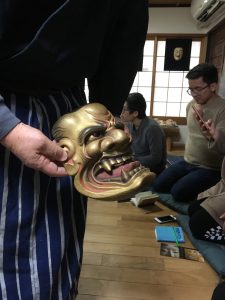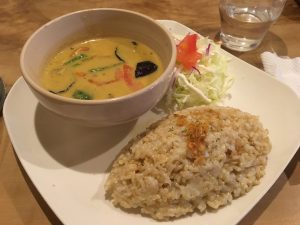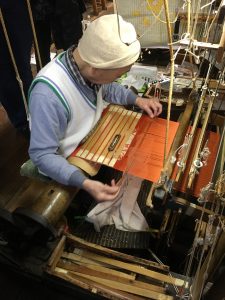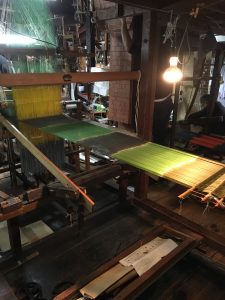We called taxis today at 9:30am to get to Ohtsuki Kokun-sensei’s residence. He is an artisan mask maker, and as we walked to the second floor studio, we could see a large variety of Noh, kyogen, and okina masks that were displayed in front of us, with short descriptions of each. When initially walking around the room, I was amazed at a photo of him, where he was surrounded by masks that he made, deep in concentration, almost similar to how he was now, surrounded by masks in a sort of gallery display.
We settled down around the displays as he began to talk about his life and how he became a craftsman. Particularly interesting to me was what he said drew him in to the world of Noh mask makig. There are no lies in how wood is cut. There is, in essence (a word I have been using a lot recently), something honest about Noh masks. Ohtsuki-sensei’s training on his road to becoming a Noh mask artisan was a great one, with years of practice, complete with allergic reactions to lacquer, carpal tunnel, and constant practice, balanced with a part time job of soba soup making in the early mornings. There was somehow a very humanizing quality to listening to that–this is a man who has spent years of his life dedicated to mastering his craft, but these crafts are not something one has “talent” for–it is something that you build up over time, and it is not a graceful process by any means.
Along the lecture, Ohtsuki-sensei picked up quite a few masks, explaining them in detail. I was particularly interested in the bronzework–how some of the teeth and eyes of masks are bronze. In turns out that there is also metalwork going on: these pieces are layered with fine bronze in themselves, giving them an ethereal kind of quality.

We also talked about how the masks were created appropriately. In Noh masks, it requires a sense of concetration and seriousness. One must be centered and focused when making a Noh mask. When it comes to kyogen, however, the masks are technically the same, however, you should have a relaxed feel that is free when making a kyogen mask.
As Ohtsuki-sensei had a class at 1PM, we ran to cafe for a vegetarian lunch. The green curry was delicious!

We hurried over to the Noh costume studio. While we were used to seeing artisans that had complete control over all processes of their arts and crafts, the costumes were special in that many people had a hand in making them. We walked into the studio, and Monica Bethe explained in detail each loom and their purpose, and we were able to see the different weaving and grounding processes that were involved in giving Noh costumes the life that we see on stage. It was so mesmerizing to see each thread being weaved into the loom and fabric!


Unfortunately, it was also a shame to hear that Satsuki-sensei was unsure about the future of the business. It seems that Noh is on the decline, and that it would be difficult to see what the future would hold.
In all, the future of things always seem to be unsure. While performance and traditions can be maintained, the same cannot necessarily always be said for businesses.
Afterwards, we quickly explored Nishiki Market in order to buy food for our group dinner, meeting up afterwards to talk about our experiences in the program in a friendly manner. Finally, we nervously went over our presentations. It’s an early day in, except I might need a drink…

